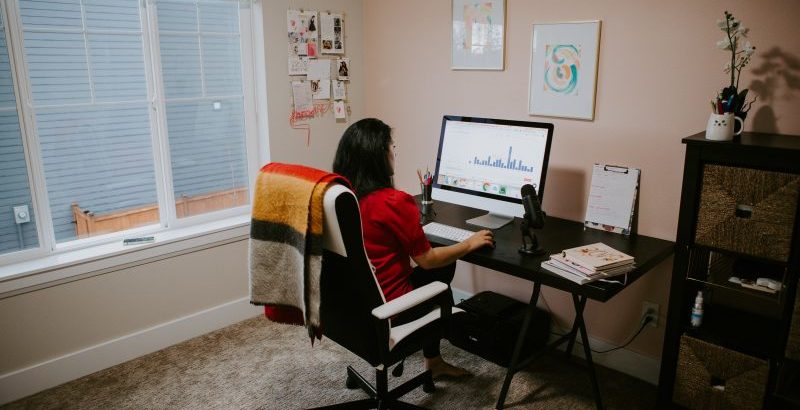[Update: This story was updated on March 18 to reflect new guidance from the Office of Management and Budget and the resignation of Office of Personnel Management Director Dale Cabaniss.]
Despite clear calls from public officials for people to refrain from large social gatherings, keep school-aged children home and work remotely to the extent possible, many government employees remain in limbo about their options to work from home in the midst of the coronavirus pandemic.
But stronger guidance issued by the Office of Management and Budget (OMB) on March 17 aims to change that. In the memo, OMB Acting Director Russell Vought told agencies to “maximize telework across the nation for the Federal workforce (including mandatory telework, if necessary), while maintaining mission-critical workforce needs.” Agencies have also been instructed to extend telework flexibilities to their contractor employees where feasible.
By Thursday, agencies are expected to “review, modify, and begin implementing risk-based policies and procedures based on CDC [Centers for Disease Control and Prevention] guidance and legal advice, as necessary to safeguard the health and safety of Federal workplaces to restrict the transmission of COVID-19.”
In recent days, OMB’s tone has shifted from encouraging to asking and now mandating that agencies implement telework and also “reduce and re-prioritize non-mission-critical services to free up capacity for critical services.”Meanwhile, many federal employees have been in limbo about their ability to telework.
Adding another layer of uncertainty to the administration’s communications about COVID-19 and the federal workforce was the abrupt resignation of Office of Personnel Management (OPM) Director Dale Cabaniss on March 17. According to reports, Cabaniss resigned after battling months of tension with White House budget office and more recently feelings of being hamstrung in her efforts to communicate clear direction to the federal workforce on how to respond to the coronavirus pandemic.
We put together this post to respond to the pressing concerns that we heard from our community around how employees should get clarity about their telework options. In some cases, the onus has been on employees to approach their managers, armed with a strong case for why they should be able to work remotely.
“A lot of empowerment has been taken away from first-line managers,” said Mika Cross, a federal workplace expert. “We need … a stronger leadership commitment at all levels and to empower those who are managing people to make the right decisions for their people.”
OMB is now directing agencies to “consider streamlining regulations and approval processes for critical services, including issuing general waivers policies and delegating decision-making where appropriate.”
GovLoop has heard from employees who are still working in the office or unsure about their office telework policy for the COVID-19 pandemic. These employees expressed concerns about their families’ safety and the safety of their colleagues who are coming into the office, amid calls for social distancing and new reports of COVID-19 cases popping up at federal agencies. The National Institutes of Health, the Agriculture Department and the Centers for Disease Control and Prevention are among the agencies that have reported at least one coronavirus case among their workforces.
Readers have also questioned why agencies haven’t already implemented telework more widely and if their department is taking the well-being of the workforce seriously.
To better help employees and managers navigate these uncharted waters of mass telework during a pandemic, GovLoop spoke with officials from OMB, the Office of Personnel Management (OPM) and federal workplace experts. Here’s what you need to know.
What is OMB’s guidance around telework?
The government’s response to the COVID-19 pandemic is fluid, and OMB’s guidance has struggled to keep pace in many cases. (You can find all OMB memos here.)
As of March 17, agencies have been instructed to maximize telework across the nation, including at headquarters and for the 85% of the federal workforce that is outside of the Washington, D.C., area. The guidance also says that:
Non-mission-critical functions that cannot be performed remotely or that require in-person interactions may be postponed or significantly curtailed. Agency heads have flexibility to realign individuals or work units to higher priority activities. Agency heads shall utilize the full extent of their legal authority and discretion to execute this realignment of non-mission-critical activities, while also ensuring that their agencies continue to serve the American people and operate in the most efficient manner possible to deal aggressively and promptly with the current situation.
In it’s March 15 memo, OMB made clear that telework guidance applied to those who may not have been considered “at higher risk” for serious complications due to COVID-19, such as older adults or those who have serious chronic medical conditions. Initially, there was no clarity around telework options for people who wished to work home out of an abundance of caution, for example.
How agencies define “essential” work varies, so you should have an honest conversation with your manager about what flexibilities are available and potential work arrangements that could allow for you to telework a portion of the day or week (we go into further details about this later in the post).
What is OPM’s messaging around telework and the government’s operating status?
OPM updated its telework messaging and changed the operating status of the federal government to “open” with maximum telework flexibilities to those who are eligible. Per opm.gov: “Open with maximum telework flexibilities to all current telework eligible employees, pursuant to direction from agency heads.”
“Agencies continue to serve the American people and conduct mission-critical functions. Each employee should refer to their own agency for communications and guidance on telework or leave status.”
Why didn’t OPM require agencies to allow telework sooner?
Many GovLoop readers were baffled to learn that OPM — the same agency issuing governmentwide COVID-19 guidance and making determinations about weather-related office closures — does not have statutory authority over telework.
Essentially, each agency is responsible for determining when and how to use telework that best suits its mission and workforce.
What if my school-aged child is working from home or I have a family member to care for?
Although OPM does provide guidance on this, the ultimate authority lies within each agency. We have seen language from agency leaders empowering supervisors to allow telework-eligible employees with children or those who are providing elder care to telework.
But, expect that your manager will require you to account for non-work hours spent caring for a child or dependent. You may be required to use leave (paid or unpaid) to accommodate your schedule.
At this point, your best bet is speaking directly with your manager about your current situation. Managers should be having these conversations proactively with direct reports, but that has not always happened in a timely manner. Together, you and your manager can talk about your specific situation and what resources and flexibilities you might need to take care of your family while also fulfilling work duties. That might include using a flexible work schedule.
For example, see if there’s an option to have “hot hours,” where everyone is available for meetings, phone calls or virtual drop-ins. For example, you might work your required 8 hours in spurts, from 6 a.m. to 10 a.m. followed by the hot hours from 10 a.m. to 2 p.m. Meanwhile, your colleague, who needs to work in the evening, might work the hot hours and then 6 p.m. to 10 p.m.
Why didn’t agencies already have telework agreements in place for employees, notifying them if they were eligible or not?
Governmentwide, there has not been consensus on the proven role that telework plays in the overall continuity of operations planning — the ability for agencies to carry out essential functions without disruption, during emergencies or critical situations.
Under the Trump administration, there has been a more restrictive approach to telework, with some agencies reducing the number of days employees could work remotely.
“The definition of [telework] eligible varied, and the assumption by many agencies is if we determine you are eligible for telework, that means that you are automatically going to want or need to have an entitlement to work on a recurring basis,” said Cross, a former federal employee who has experience with designing telework programs for both civilian and intelligence agencies. “That is not the case.”
Under the 2010 Telework Enhancement Act, executive agencies are required to incorporate telework into their Continuity of Operations (COOP) plans, but in recent days managers have been scrambling to sign new agreements enabling employees to telework or updating existing agreements to provide greater flexibility.
What if I don’t have a telework agreement?
If you do not have a telework agreement or are unsure about what is in your agreement, you definitely want to proactively talk to your manager about it. As noted earlier, agencies have the authority to expand telework eligibility, even to employees who previously may not have been considered telework-eligible.
What if I am not telework-eligible? What are my options?
Now is the time for managers to revisit these determinations, erring on the side of ensuring that employee safety and agency mission are fairly considered.
Per the telework law, there is a clear distinction between “eligibility” and “participation.” To be able to participate in telework, an employee must first be identified as eligible. The law only specifies two instances where employees are not eligible. Those include 1) If an employee is officially disciplined for being absent without permission for more than five days in any calendar year; and 2) If an employee has been officially disciplined for reviewing, downloading or exchanging pornography, including child pornography.
Cross notes that “if an employee is eligible to telework even a portion of the duty day, they are eligible. But the frequency of which they are approved to telework, that is what agencies have the discretion to determine.”
This is an opportunity for employees and managers to work together and find a path forward to make telework work for all sides. Cross shared that even as an employee in the intelligence community, she teleworked with regularity. A portion of the work had to be done in the office, but a percentage of her duties could also be done remotely.
Her advice:
- Map out any potential roadblocks up front, and communicate with your supervisor about what contingencies are in place to address them.
- Remember that there are different categories of work that can be considered duty work, such as reading, research and generating new ideas for doing business differently. These types of assignments are good to keep in mind, for example, if you lose network connectivity during the workday.
- Identify a virtual office buddy, someone who can have your back and fill in for you if needed.
- Know what communications channel your supervisor expects you to use, and get clarity around how you should check in with colleagues, customers or managers if there is a change in schedule due to unforeseen events.
Photo Credit:ConvertKit on Unsplash





Thank you for writing on this topic! -Very informative.
You are most welcome! Whatever we can do to help share information and insights, let us know.
[…] POLICY Updated: Are You in Limbo About Your Telework Status? “Despite clear calls from public officials for people to refrain from large social […]